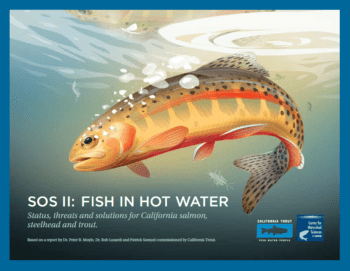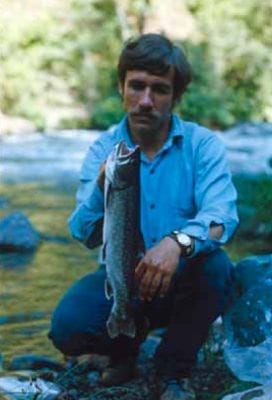“State of Salmonids II” report released by CalTrout and UC Davis Center for Watershed Sciences
California Trout and University of California Davis, Center for Watershed Sciences, provided key results from an in-depth report today detailing the status of 32 types of salmon, steelhead, and trout that are native to California. State of the Salmonids II: Fish in Hot Water offers concerning data about the declining health of these fish populations and opportunities for stabilizing and even recovering many species.
SOS II: Fish in Hot Water is the second such report released by CalTrout and UC Davis, Center for Watershed Sciences. The first edition was published in 2008 and established a baseline level of health for each of 32 types of native salmon, steelhead, and trout populations in the state (including the extinct Bull trout). Since that time, the number of California’s native fish species likely to be extinct within the next five decades nearly tripled, from 5 to 14 species. And after five years of historic drought, 81 percent of the remaining 31 species are worse off today than they were a decade ago.
“The health of our native fish is a reflection of the health of our rivers and streams,” said Curtis Knight, Executive Director of CalTrout. “Declining fish populations indicate degraded waters, which threatens the health and economic well-being of all Californians.”
If present trends continue, 74 percent of California’s native salmon, steelhead, and trout species are likely to be extinct in 100 years.
Lead report author Dr. Peter Moyle, Distinguished Professor Emeritus in the Department of Wildlife, Fish and Conservation Biology and Associate Director of the Center for Watershed Sciences, UC Davis, noted, “This report should rightly be considered an alarm bell, but it should also be seen as a roadmap for how we can correct course to better support native aquatic species. Thanks to ongoing scientific research, we now know what to do – and where – to improve the plight of native fish.”
The report includes an analysis of key threats to the survival of each species, starting with the overarching threat of climate change, which is likely to reduce the availability of cold water habitat that salmon, steelhead, and trout all depend on for survival. It also highlights various other human-induced threats, such as dams, agriculture, estuary alteration, urbanization, and transportation.
“We have already lost one of our native fish,” Knight added. “The Bull trout was last seen in the McCloud River in 1975. The fact we haven’t lost another since 1975 is remarkable. These fish are resilient, but this report underscores that we must act now to prevent further extinctions.”
The report notes that improving salmonid status throughout California requires investing in productive habitats that promote growth, survival, and diversity. CalTrout has developed an action plan to return the state’s salmon, steelhead, and trout to resilience to help many of these species thrive.
To reverse the trend toward extinction, the report suggests prioritizing protection and restoration efforts in three general areas:
- Protecting the most productive river ecosystems remaining in California, such as the Smith and Eel Rivers, must be a priority. These strongholds, among others, have the capacity to support diversity and abundance because they retain high quality habitat and are not heavily influenced by hatcheries, supporting the persistence of wild fish.
- Increasing focus on source waters will keep more water in streams and reduce stress on fish during drought, buffering the effects of climate change. Sierra meadow restoration, springs protection and progressive groundwater management all contribute to this effort.
- Restoring function to once productive – but now highly altered – habitats can greatly improve rearing conditions for juvenile fish, especially floodplains, coastal lagoons, estuaries, and spring-fed rivers.
Additionally, “SOS II: Fish in Hot Water” identifies three science-based strategies to support a return to abundance for California’s native salmonids:
- First, focus on opportunities to mimic natural processes within altered landscapes. For example, CalTrout has demonstrated that off-season farmland can mimic traditional floodplains and support rapid growth of juvenile salmon.
- Second, prioritize improving fish passage to historical spawning and rearing grounds that have been cut off over time.
- Last, pursue strategies that increase genetic diversity of wild fish.
“We know we are not going to turn back the clock to a time before rivers were dammed or otherwise altered for human benefit,” Knight said. “Using the best available science, we can make landscape-level changes that will allow both people and fish to thrive in California.”
The longer, full report is expected this summer.
To read the report’s main findings and explore related online resources, go to www.caltrout.org/sos/
For a blog post from UC Davis authors Peter Moyle and Robb Lusardi on May 16, visit https://californiawaterblog.com/
Key Facts from State of Salmonids II: Fish in Hot Water
- 45 percent of California’s salmon, steelhead and trout are likely to be extinct in next 50 years if present trends continue. 74 percent will likely to be extinct in next 100 years if present trends continue.
- Only coastal rainbow trout have a good chance for survival if present trends continue.
- The number of species likely to be extinct in 50 years increased 180 percent in the last 10 years – from just 5 in 2008 to 14 today.
- Of California’s remaining salmon, steelhead and trout, 81 percent are worse off today than in 2008.
- California will lose more than half (52 percent) of its native anadromous (migratory) salmonids, and over a quarter (27 percent) of its inland salmonids in the next 50 years if present trends continue.
California’s Native Salmon, Steelhead and Trout (fish in bold face the most immediate threat):
Salmon
- Central California Coast Coho Salmon
- Chum Salmon
- Pink Salmon
- California Coast Chinook Salmon
- Central Valley Late Fall-run Chinook Salmon
- Central Valley Spring-run Chinook Salmon
- Sacramento River Winter-run Chinook Salmon
- Southern Oregon/Northern California Coast Coho Salmon
- Upper Klamath-Trinity Rivers Spring-run Chinook Salmon
- Upper Klamath-Trinity Rivers Fall-run Chinook Salmon
- Central Valley Fall-run Chinook Salmon
- Southern Oregon/Northern California Coast Chinook Salmon
Steelhead
- Klamath Mountains Province Summer Steelhead
- Northern California Summer Steelhead
- South-Central California Coast Steelhead
- Southern Steelhead
- Central California Coast Steelhead
- Central Valley Steelhead
- Northern California Winter Steelhead
- Klamath Mountains Province Winter Steelhead
Trout
- Bull Trout* – extinct since 1975
- California Golden Trout
- Eagle Lake Rainbow Trout
- Kern River Rainbow Trout
- Lahontan Cutthroat Trout
- Little Kern Golden Trout
- McCloud River Redband Trout
- Paiute Cutthroat Trout
- Coastal Cutthroat Trout
- Goose Lake Redband Trout
- Coastal Rainbow Trout
- Mountain Whitefish*






